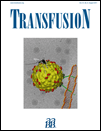Prevalence of antibodies to hepatitis B core antigen and occult hepatitis B virus infections in Korean blood donors
This study was supported by a research grant from the Korean Red Cross in 2008.
Abstract
BACKGROUND: This study was performed to determine the prevalence of antibodies to hepatitis B core antigen (anti-HBc) among Korean blood donors and frequencies of hepatitis B virus (HBV) DNA and antibodies to hepatitis B surface antigen (anti-HBs) in anti-HBc–positive donors.
STUDY DESIGN AND METHODS: A total of 12,461 consenting blood donors were consecutively enrolled from Korean Red Cross Blood Services from April to October 2008. All of the donors were screened for anti-HBc with an electrochemiluminescence immunoassay. Repeat-reactive anti-HBc–positive donors were assayed for anti-HBs and for HBV DNA using a multiplex test (Cobas TaqScreen, Roche Molecular Systems) on individual donation.
RESULTS: Of the 12,461 donors, 1682 (13.5%) were reactive for anti-HBc. Among different age groups, there was a steady increase in the anti-HBc–positive rate, ranging from 2.0% in the age group of less than 20 years to 80.0% in the age group of 60 years and older (p < 0.0001). Of the anti-HBc–positive donors, 1523 (90.5%) were anti-HBs positive. HBV DNA was detected in two donors who were anti-HBc positive and hepatitis B surface antigen negative. The prevalence of occult HBV infection was 0.016%, and the HBV nucleic acid test (NAT) yield was 1 in 838 (0.12%).
CONCLUSION: This study helps to determine the current status of hepatitis B infection and the prevalence of occult HBV infection in the blood donor population in Korea. We estimate that in Korea, up to 161 units per million donated units from blood donors may contain HBV DNA. Although the potential infectivity of these units has been debated upon, the HBV NAT assay could prevent certain transfusion-transmitted HBV infections.




